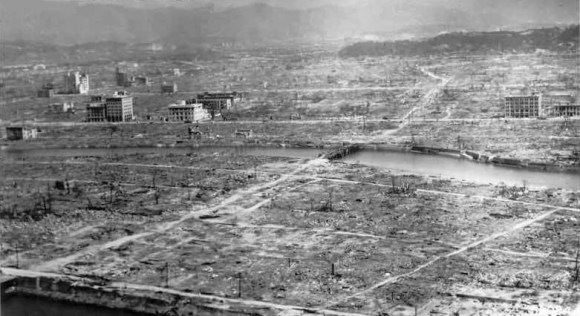
On Wednesday of last week, the city of Hiroshima marked the 69th anniversary of the atomic bombing. When the bomb detonated in the air above Hiroshima on August 6, 1945, it destroyed the city and killed up to 140,000 people. Almost everything in a one-mile radius of the target site was immediately razed to the ground. On August 9, a second bomb was dropped on Nagasaki, killing a further estimated 70,000.
Hiroshima was chosen as the primary target for a number of reasons. The US wanted a target city with an urban area of at least three miles diameter. It also had to have been untouched by other air raids, so that the weapon’s impact could be accurately observed. Hiroshima was also thought to be the only potential target city that did not have any Allied prisoner-of-war camps.
But what if the A-bomb had been detonated over Tokyo instead? Or Osaka? Using statistics collated by Dr. Mark A. Carlson at the University of Nebraska, the Japanese Huffington Post has produced this interactive Google map answering just that question.
Japanese officials have estimated that 69 percent of Hiroshima’s buildings were destroyed in the bombing and fires that followed it. This first map shows how Tokyo – of course, a much bigger city – would have been affected by the blast, had it been the primary target instead of Hiroshima.
If the A-bomb had been dropped over Tokyo central station:
- The area from Kanda in the north to Higashi-Ginza in the south would have been completely destroyed (the shaded black area on the map).
- Around that black area is a red shaded circle, which would have faced “severe” direct damage.
- The next ring out (yellow) is an area of 3.5 km in diameter. Circled by Kiba, Yotsuya, Ueno and Hamamatsuchō, this is the area where buildings would have collapsed and caught fire.
- In the outer-most ring (red), an area 7 km across, windows would have been shattered by the impact. This stretches as far as Shinagawa, Shinjuku, Minamisenju, and Higashi-ōjima.
A second map shows a projection of the damage, had the Abomb been dropped over Osaka, in the central area including Namba and Shinsaibashi:
The makers of these two interactive maps have also made a separate set of projections using the data from Tsar Bomba, the AN602 hydrogen bomb which was detonated in 1961.
The Soviet test of Tsar Bomba, the most powerful man-made explosion in human history, produced around 1,500 times the combined power of the bombs that destroyed Hiroshima and Nagasaki. If it had been dropped on Tokyo, the range of the impact would have been enormous, reaching to Mt. Fuji:
This map shows the projection over Osaka, where the impact would have reached right across the Kansai region:
You can check out the interactive maps of for yourself (Tokyo or Osaka): on the left hand panel, the top check box (水爆「ツァーリ・ボンバ」) shows the projections for Tsar Bomba, while the second (広島型原爆) shows the Hiroshima bomb.
What does it mean to produce images like this, that use kilometres and place names as a way of looking at historical events? Much of the work done by the Hiroshima Peace Memorial Museum has focused on human stories as a means to understanding the impact of the Hiroshima and Nagasaki bombings. Rather than relying on statistics, the museum’s (occasionally controversial) impactful displays include belongings, photos and first-hand accounts of the horror and pain experienced by real people.
There was never any suggestion of an A-bomb being dropped on Tokyo, so this isn’t a historical “what-if”. But by transplanting the bombings to another location, these maps make it more understandable to people from that place. It provides something of a visual key to understanding the scale of events – for those familiar with the Tokyo or Kansai regions, anyway – and a reminder of the enormous scale of the suffering inflicted by the bombing, as we look back 69 years later.
Sources: Huffington Post JP, Hiroshima City Virtual Museum
Top image: U.S. Navy Public Affairs/Wikipedia
Images: Google Maps (1, 2)